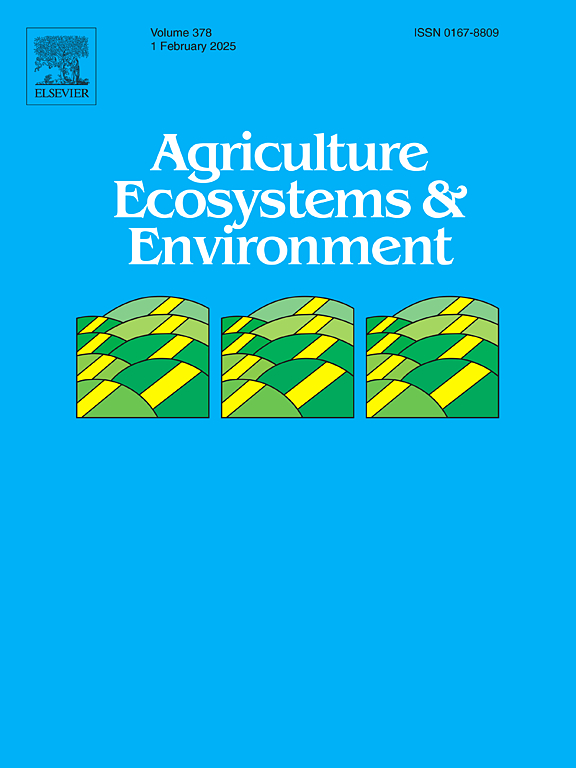在西部玉米带,饲料谷物复合栽培减轻了天气风险,支持节肢动物,并抑制了杂草
IF 6.4
1区 农林科学
Q1 AGRICULTURE, MULTIDISCIPLINARY
引用次数: 0
摘要
在极端天气下确保可持续粮食生产,同时保护生物多样性和生态系统服务是一项挑战。我们评估了间作是否可以提高产量、饲料质量和作物生产的稳定性,同时也为有益的节肢动物提供栖息地,从而改善害虫捕食等生态系统服务。该研究于2023年在SD布鲁金斯进行,在两种天气环境下进行,种植A在发芽时较冷,开花时较热,通常比种植b更干燥。处理包括燕麦和豌豆单一栽培,燕麦-豌豆双栽培,以及种植A,燕麦-豌豆-亚麻三合一栽培。151年整体粮食产量2247 ± 公斤 公顷−1,2498 ±109 公斤 公顷−1,和1423年 ±158 公斤 公顷oat-pea−1,燕麦,分别和豌豆。单种栽培的产量在两种天气条件下存在差异,种植B的燕麦和豌豆产量比种植a的燕麦和豌豆产量分别高出30.4 %和113 %。然而,双种栽培的产量在不同天气条件下没有差异(p = 0.3)。双、三联栽培的土地利用效率至少与单联栽培一样,即使在热胁迫条件下也能提供稳定的生产力和饲料质量。粗蛋白质、酸性洗涤纤维和总可消化营养物质含量均高于燕麦,中性洗涤纤维含量较低,而豌豆粗蛋白质含量最高,纤维含量最低。两种复合栽培均改善了掠食性节肢动物的生境,有效地抑制了杂草的生长。综上所述,间作可提高饲料粮生产的生产率、稳定性和长期可持续性。本文章由计算机程序翻译,如有差异,请以英文原文为准。
Feed grain polycultures mitigate weather risk, support arthropods, and suppress weeds in the Western Corn Belt
Ensuring sustainable food production while preserving biodiversity and ecosystem services under extreme weather is a challenge. We evaluated whether intercropping could enhance the yield, feed quality, and stability of crop production while also provisioning habitat for beneficial arthropods which could improve ecosystem services like pest predation. The study was conducted across two weather contexts at Brookings, SD, in 2023, with Planting A being cooler at germination, warmer at flowering, and generally drier than Planting B. Treatments included oat and pea monocultures, an oat-pea biculture, and in Planting A, an oat-pea-flax triculture. Overall grain yields were 2247 ± 151 kg ha−1, 2498 ± 109 kg ha−1, and 1423 ± 158 kg ha−1 for oat-pea, oat, and pea, respectively. Yields of monocultures varied between the two weather contexts, with 30.4 % and 113 % higher yields of oats and peas in Planting B versus Planting A. However, the biculture yields were not different across weather conditions (p = 0.3). The bi- and tri-cultures were at least as land-use efficient as monocultures while providing stable productivity and feed quality even under heat-stressed conditions. The oat-pea mix also had higher crude protein, similar acid detergent fiber and total digestible nutrient, and lower neutral detergent fiber content versus the oat grain, while pea had the highest crude protein and lowest fiber content. Both polycultures improved the habitat for predatory arthropods and effectively suppressed weeds. Our findings suggest that intercropping could improve the productivity, stability, and long-term sustainability of feed grain production.
求助全文
通过发布文献求助,成功后即可免费获取论文全文。
去求助
来源期刊

Agriculture, Ecosystems & Environment
环境科学-环境科学
CiteScore
11.70
自引率
9.10%
发文量
392
审稿时长
26 days
期刊介绍:
Agriculture, Ecosystems and Environment publishes scientific articles dealing with the interface between agroecosystems and the natural environment, specifically how agriculture influences the environment and how changes in that environment impact agroecosystems. Preference is given to papers from experimental and observational research at the field, system or landscape level, from studies that enhance our understanding of processes using data-based biophysical modelling, and papers that bridge scientific disciplines and integrate knowledge. All papers should be placed in an international or wide comparative context.
 求助内容:
求助内容: 应助结果提醒方式:
应助结果提醒方式:


